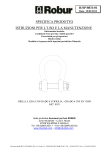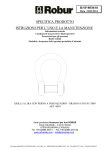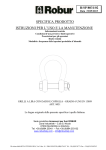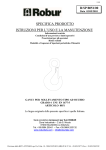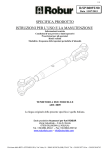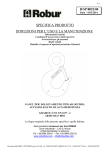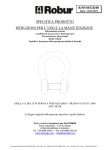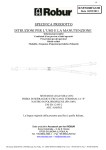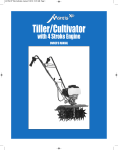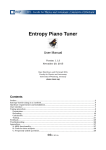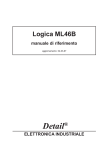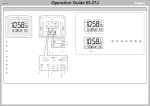Download specifica prodotto istruzioni per l`uso e la manutenzione
Transcript
1/11 R/SP/8032/02 Data 30/10/2015 SPECIFICA PRODOTTO ISTRUZIONI PER L’USO E LA MANUTENZIONE Informazioni tecniche Condizioni d’uso previste e limiti operativi Prescrizioni per gli operatori Rischi residui Modalità e frequenza delle ispezioni periodiche d’idoneità GRILLI A LIRA CON PERNO A FORO QUADRO PER SOLLEVAMENTO GRADO 6 UNI EN 13889 ART. 8032 La lingua originale della presente specifica è quella Italiana. Sede produttiva Accessori per funi ROBUR Zona Industriale – C.da S. Nicola 67039 SULMONA (L’AQUILA) Tel. +39.0864.2504.1 – Fax +39.0864.253132 www.roburitaly.com – [email protected] Divisione della BETA UTENSILI SPA, Via Volta, 18 - 20845 SOVICO (MB) ITALY Tel. +39.(0)39.20771-Fax + 39.(0)39.2010742 2/11 1) CARATTERISTICHE TECNICHE Materiale: STAFFA acciaio da bonifica PERNO acciaio da bonifica Trattamento Termico: Bonifica Norme di Riferimento: Grillo Materiale Trattamento Superficiale: STAFFA zincata a caldo per immersione PERNO zincato A2E EN ISO 4042 e verniciato arancione (RAL 2011) UNI EN 13889 UNI EN 10084 Il collaudo viene eseguito in base a specifiche e regole interne in riferimento alla norma UNI EN ISO 9001. L’articolo è conforme alla Direttiva Macchine 2006/42/CE. Divisione della BETA UTENSILI SPA, Via Volta, 18 - 20845 SOVICO (MB) ITALY Tel. +39.(0)39.20771-Fax + 39.(0)39.2010742 3/11 CARATTERISTICHE DIMENSIONALI: TABELLA “A” MISURA FILETT. N° Filetti per pollice 16 19 22 25 5/8 3/4 7/8 1” 11 10 9 8 ØA B 48.0 60.0 71.0 84.0 C 33 43 51 58 D D mm Poll. 12.7 16.0 19.0 22.0 1/2 5/8 3/4 7/8 D1 E F H K g 30 40 48 54 51 63 74 86 47.0 59.0 70.0 81.0 21.0 27.0 32.0 37.0 11 310 11 560 11 980 13 1460 WLL CODICE kg 2000 3250 4750 6500 080320012 080320016 080320020 080320022 Le quote indicate sono espresse in mm. WLL= CARICO MASSIMO DI ESERCIZIO COEFFICIENTE DI SICUREZZA: 6 ATTENZIONE: il coefficiente di sicurezza è soltanto un’indicazione per la sicurezza del prodotto. Non si devono mai superare i carichi (WLL) indicati nella tabella. Divisione della BETA UTENSILI SPA, Via Volta, 18 - 20845 SOVICO (MB) ITALY Tel. +39.(0)39.20771-Fax + 39.(0)39.2010742 4/11 Definizioni: • Carico massimo di esercizio (WLL): è il carico massimo che l’articolo può sopportare (lungo l’asse principale, se non diversamente indicato) in condizioni di utilizzo. • Coefficiente di sicurezza: è il rapporto tra il carico di rottura minimo garantito e il carico limite di lavoro. • Ispezione: controllo visivo relativo allo stato del grillo per individuare evidenti danneggiamenti o usure che possono alterarne l’utilizzo. • Esame accurato: esame visivo effettuato da una persona competente e, se necessario, coadiuvato da altri mezzi, quali i controlli non-distruttivi, al fine di individuare danneggiamenti o usure che possono alterare l’utilizzo del componente. • Persona competente: persona designata, istruita correttamente, qualificata per conoscenza ed esperienza pratica, che ha ricevuto le istruzioni necessarie per eseguire le prove e gli esami richiesti. 2) SPECIFICHE DI COLLAUDO L’accessorio è sottoposto a una serie di controlli a campione per accertarne la funzionalità prestazionale e la rispondenza alla norma UNI EN 13889. La numerosità del campione e i relativi piani di campionamento sono scelti in funzione della caratteristica da verificare in accordo e per quanto previsto dalla norma UNI ISO 2859/1, e i risultati archiviati nell’ufficio qualità dello stabilimento di Sulmona. 2.A Controllo visivo Verifica la presenza di eventuali imperfezioni dovute a stampaggio, lavorazione meccanica, rivestimento superficiale e rispondenza della marcatura a disegni di fase interni. 2.B Controllo dimensionale Verifica che le dimensioni dell’articolo rientrino nelle tolleranze stabilite dai relativi disegni di costruzione interni. 2.C Analisi chimica Verifica la rispondenza della composizione chimica del materiale. 2.D Analisi metallografica Verifica il processo di bonifica: a 500 ingrandimenti si deve riscontrare una distribuzione omogenea di martensite rinvenuta. 2.E Prove di trazione Verifica che l’accessorio sottoposto a una trazione arrivi a rottura dopo che la forza applicata abbia almeno superato il “WFL” moltiplicato per il coefficiente di sicurezza. La prova è eseguita in accordo con la norma UNI 10002/1. 2.F Prova di fatica Verifica che l’articolo sottoposto a trazione per 20.000 cicli con un carico di 1,5 volte il “WFL” indicato nella tabella A non subisca rotture. 2.G Prova di durezza Verifica che la durezza dell’articolo rientri nei valori stabiliti dai relativi disegni di costruzione interni. 2.H Prova di resilienza Verifica la tenacità del materiale: i provini di materiale, portati alla temperatura di 20°C e sottoposti al test d’urto di Charpy, dovranno fornire un valore medio dell’energia assorbita dopo l’impatto di almeno 27J. La prova è eseguita in accordo alle norme UNI EN 13889, EN 10045-1, EN 10045-2. Divisione della BETA UTENSILI SPA, Via Volta, 18 - 20845 SOVICO (MB) ITALY Tel. +39.(0)39.20771-Fax + 39.(0)39.2010742 5/11 3) COME LEGGERE LA MARCATURA Sull’accessorio sono stampate in maniera indelebile marcature e sigle che identificano il prodotto e ne definiscono le caratteristiche e applicazioni. MARCATURA 1) Misura 2) Carico massimo di esercizio 3) Marchio produttore 4) Marchio CE 5) Grado materiale 6) Codice di rintracciabilità La posizione della marcatura sul disegno è solo indicativa. Realmente le posizioni delle varie voci possono trovarsi in punti differenti. 4) AVVERTENZE GENERALI Il manuale deve essere custodito da persona responsabile allo scopo preposta, in un luogo idoneo, affinché esso risulti sempre disponibile per la consultazione nel miglior stato di conservazione. In caso di smarrimento o deterioramento, la documentazione dovrà essere prontamente sostituita scaricandola dal sito del costruttore: www.roburitaly.com. Il costruttore si riserva la proprietà materiale ed intellettuale del presente manuale e ne vieta la duplicazione, anche parziale, per fini commerciali. Con riferimento a quanto riportato in queste istruzioni d’uso, BETA UTENSILI SPA declina ogni responsabilità in caso di: • • • • • • uso degli accessori contrario alle leggi nazionali sulla sicurezza e sull’antinfortunistica; errata scelta o predisposizione del mezzo con il quale saranno connessi; mancata o errata osservanza delle istruzioni per l’uso; modifiche agli accessori; uso improprio e omessa manutenzione ordinaria; uso combinato ad accessori non conformi. !ATTENZIONE: I dati di marcatura non devono essere rimossi con molature o abrasioni, (neanche accidentali; i grilli senza riferimenti di identificazione devono essere resi inutilizzabili e rottamati). Non è consentito apporre caratteri aggiuntivi a quelli di fabbricazione. Divisione della BETA UTENSILI SPA, Via Volta, 18 - 20845 SOVICO (MB) ITALY Tel. +39.(0)39.20771-Fax + 39.(0)39.2010742 6/11 5) CRITERI DI SCELTA I parametri che devono essere attentamente considerati nella scelta dei grilli sono: 5.A CARICO MASSIMO DI ESERCIZIO Il peso del carico da sollevare deve essere inferiore o uguale al valore del carico massimo di esercizio (WLL) previsto per il grillo preso in considerazione, stampato sul prodotto e riportato nella tabella “A”. 5.B ELEMENTO DI ACCOPPIAMENTO Assicurarsi che l’elemento di accoppiamento sia adeguato alle caratteristiche di portata del grillo, abbia uno spessore e una composizione chimica adeguati e garantisca una resistenza meccanica sufficiente alla trazione esercitata dalla presa. 5.C TEMPERATURE D’IMPIEGO La temperatura d’impiego consentita dovrà essere compresa tra –20 °C e +200 °C. Al di fuori di questi valori non è più garantito il carico massimo di utilizzazione. 6) CONDIZIONI NON AMMESSE Non è consentita la movimentazione dei seguenti carichi: • • • • • • aventi un peso superiore al carico massimo di esercizio; aventi una struttura non sufficientemente resistente alla trazione esercitata dalla presa; aventi temperature superiori o inferiori a quelle ammesse; classificati come pericolosi (p. es. metalli fusi, materiali infiammabili, corrosivi, fissili, esplosivi ecc.); che possono cambiare la loro configurazione statica e/o il loro baricentro o il loro stato chimicofisico; immersi in soluzioni acide o esposti a vapori acidi. 7) CONTROLLI PRELIMINARI Prima della messa in servizio e/o del montaggio gli accessori devono essere controllati da una persona competente adeguatamente addestrata. • Controllare l’integrità dell’accessorio e in particolare che non vi siano tagli, piegature, incisioni, abrasioni, incrinature o cricche, filetti irregolari, corrosioni, bave taglienti, usure provocate dall’utilizzo o difetti dovuti a cattivo stoccaggio. • Rilevare e registrare le dimensioni con riferimento alla tabella “A”. • Controllare l’integrità della marcatura in tutte le sue parti, sia della staffa che del perno, in particolare le prescrizioni di portata e grado del materiale, al fine di identificare con precisione l’accessorio in funzione del carico di lavoro. • Verificare la bontà dell’accoppiamento tra staffa e perno e tra i filetti. Divisione della BETA UTENSILI SPA, Via Volta, 18 - 20845 SOVICO (MB) ITALY Tel. +39.(0)39.20771-Fax + 39.(0)39.2010742 7/11 8) INSTALLAZIONE - ISTRUZIONI PER IL MONTAGGIO I grilli con perno filettato sono generalmente usati come elementi mobili di unione in applicazioni non permanenti. Svitare ed estrarre il perno dalla staffa; eseguire il collegamento con l’elemento da sollevare. Avvitare a fondo il perno, verificando che sia completamente serrato contro la staffa, senza creare sovratensioni sui filetti o flessioni verso l’interno del grillo. Un appoggio scorretto del perno sulla staffa può essere dovuto al perno curvato, alla filettatura troppo serrata o rovinata, oppure al disallineamento dei fori della staffa. Non utilizzare il grillo in queste condizioni. Non sostituire mai il perno dei grilli, eccetto che con uno della stessa misura, grado del materiale, tipo e costruzione, perché può non essere idoneo per i carichi imposti. Applicare il carico sulla parte curva del grillo, realizzando un perfetto allineamento tra i vari componenti (fig.1). WLL WLL WLL CORRETTO ERRATO ERRATO Fig. 1 Sono ammessi dei distanziali liberi sul perno, per centrare il gancio ed evitare pericolose inclinazioni. Il carico massimo di utilizzazione (WLL) è riferito al sollevamento con un solo tirante dove il carico è perfettamente allineato lungo l’asse principale del grillo. Nel sollevamento con due tiranti l’angolo di apertura degli stessi non deve superare 120°. I tiranti devono essere posizionati sulla staffa, mentre il gancio va posto sul perno (fig. 2). Fig. 2 Divisione della BETA UTENSILI SPA, Via Volta, 18 - 20845 SOVICO (MB) ITALY Tel. +39.(0)39.20771-Fax + 39.(0)39.2010742 8/11 Il sollevamento effettuato con l’impiego di grilli deve essere sempre realizzato consentendo agli eventuali tiranti la piena libertà di movimento e di autoposizionamento; non devono quindi presentarsi mai forzature o interferenze tra l’elemento di sospensione e il carico da sollevare. I grilli non devono essere utilizzati in sollevamenti che generano componenti di forza laterali (fig. 3). WLL WLL CORRETTO ERRATO Fig. 3 Quando si usano i grilli nella configurazione di brache con nodo scorsoio, la parte scorrevole della fune deve passare sulla parte curva del grillo (fig. 4). Applicare, in questo caso, l’80% del carico di utilizzazione, “WLL”, indicato nella tabella “A”. CORRETTO ERRATO Fig. 4 Mettere in tensione le funi senza sollevare; controllare il baricentro e la distribuzione delle forze. Considerare che nel caso di sollevamento di carichi squilibrati con due tiranti, il peso maggiore è sempre sostenuto dal tirante più corto. Adottare gli accorgimenti più idonei per riequilibrare il carico in funzione della tipologia di imbracatura. Divisione della BETA UTENSILI SPA, Via Volta, 18 - 20845 SOVICO (MB) ITALY Tel. +39.(0)39.20771-Fax + 39.(0)39.2010742 9/11 9) USO DELL’ACCESSORIO - PRESA E MANOVRA Prestare sempre la massima attenzione a ogni specifico avvertimento per la movimentazione del carico. Prima di azionare il sollevatore, assicurarsi che il carico sia libero di muoversi e non sia bloccato da elementi di collegamento o da altri impedimenti. Mettere in tiro le funi prima di sollevare. Stare lontani con le mani o altre parti del corpo quando le funi sono poste in tensione. Il carico va sollevato lentamente, va controllato che sia sicuro e che assuma la posizione preventivata. Muovere il carico con movimenti lenti, lineari e costanti, evitando brusche accelerate o frenate che, per effetto dell’inerzia, possono creare pericolose oscillazioni. Predisporre anticipatamente il luogo di deposito al suolo del carico, assicurandosi che il terreno (o il pavimento) sia adeguatamente resistente per sopportare il carico. Assicurarsi che l’accesso al luogo di deposito sia privo di ostacoli e che le persone siano a distanza di sicurezza. Il carico deve essere appoggiato con cautela, facendo attenzione che la braca non si impigli. Prima di allentare le funi, controllare che il carico sia ben supportato e stabile. Una volta che il carico è appoggiato in sicurezza, il sistema di imbracatura deve essere rimosso a mano, e mai allontanato con l’apparecchio di sollevamento. 10) CONTROINDICAZIONI D’USO L’utilizzo dell’accessorio per scopi non previsti, il suo uso in condizioni estremamente pericolose e la carenza di manutenzione possono comportare gravi situazioni di pericolo per l’incolumità delle persone esposte e di danno per l’ambiente di lavoro, oltre che pregiudicare la funzionalità e la sicurezza effettiva del prodotto. Le azioni di seguito citate, che, ovviamente, non possono coprire l’intero arco di potenziali possibilità di “cattivo uso” dell’accessorio, costituiscono tuttavia quelle “ragionevolmente” più prevedibili. Quindi: • • • • • • • • • NON utilizzare l’accessorio collegandolo ad apparecchiature di dimensioni, temperatura, punto d’aggancio e forma non idonei alle sue caratteristiche; NON sollevare il carico sottoponendo l’accessorio a sollecitazioni di tipo pulsante; NON fare oscillare il carico durante la movimentazione; NON utilizzare l’accessorio per sollevare e trasportare carichi sospesi in volo (aeromobili); NON usare l’accessorio per trazionare carichi vincolati; NON mettere in tensione apparecchiature che possono cambiare la loro configurazione statica, il loro baricentro o lo stato chimicofisico; NON utilizzare l’accessorio per il sollevamento o il trasporto di persone o animali; NON operare in aree dove è prescritto l’uso di componenti antideflagranti/antiscintilla o in presenza di forti campi magnetici; NON saldare sull’accessorio particolari metallici, né intervenire con riporti di saldatura o utilizzarlo come massa per saldatrici. Divisione della BETA UTENSILI SPA, Via Volta, 18 - 20845 SOVICO (MB) ITALY Tel. +39.(0)39.20771-Fax + 39.(0)39.2010742 10/11 11) IDONEITÀ ALL’UTILIZZO L’accessorio è stato sottoposto a collaudo a campione presso il costruttore per accertare la rispondenza funzionale e prestazionale dello stesso. L’attestato che accompagna la fornitura certifica il superamento con esito positivo dei test di collaudo. L’utilizzatore deve eseguire in ogni caso, prima di iniziare a operare, la verifica della rispondenza funzionale e prestazionale dell’accessorio installato per confermare l’idoneità all’impiego dell’intera installazione. 12) ISPEZIONE E MANUTENZIONE Comprende una serie di operazioni eseguite da personale competente istruito allo scopo, relative a controlli ed esami accurati durante l’impiego. Di seguito l’elenco dei controlli da effettuare con cadenze indicate nella tabella “Interventi di manutenzione e controllo”. • • • • • VISIVO: verificare l’assenza di difetti superficiali, quali cricche, incisioni, tagli o fessure, abrasioni. CONDIZIONI DEL FILETTO: esaminare lo stato del filetto, che non deve presentare usure, deformazioni e ammaccature, e l’accoppiamento deve essere preciso, stabile e senza eccessivo gioco. DEFORMAZIONE: verificare che l’accessorio non sia deformato, misurando con un calibro le dimensioni critiche, come indicato nella tabella “A”. NON sono tollerate deformazioni rispetto alle quote rilevate alla prima messa in servizio. USURA: verificare che i punti di contatto non siano usurati, misurando con un calibro le dimensioni critiche indicate nella tabella “A”. STATO DI CONSERVAZIONE: verificare l’assenza di ossidazione e corrosione, soprattutto in caso di utilizzo all’aperto; verificare l’assenza di cricche con metodi idonei (p. es. liquidi penetranti). Le registrazioni di questi controlli devono essere conservate. Tabella interventi di manutenzione e controllo Tipo di controllo Controllo visivo gener. Condizioni del filetto Deformazione Usura Stato di conservazione A ogni utilizzo Mese Anno x x x x x Nel caso in cui il grillo sia sottoposto a un utilizzo gravoso, è necessario effettuare le verifiche di usura e stato di conservazione con maggiore frequenza. 13) DEMOLIZIONE E ROTTAMAZIONE DELL’ACCESSORIO L’accessorio deve essere demolito mediante taglio, in modo tale che non possa più essere utilizzato, sia al termine della vita prevista, che nel caso presenti: - una deformazione permanente rispetto alla misura originale; - eventuali cricche, distorsioni e/o se si riscontrano riduzioni di sezione rispetto alla misura originale; - se le condizioni del filetto non garantiscono il perfetto accoppiamento tra le parti, filetti usurati, deformati, irregolari ecc. Divisione della BETA UTENSILI SPA, Via Volta, 18 - 20845 SOVICO (MB) ITALY Tel. +39.(0)39.20771-Fax + 39.(0)39.2010742 11/11 Robur (divisione Beta Utensili spa) Zona industriale – c.da San Nicola 67039 Sulmona (AQ) Tel. +39.0864.2504.1 Fax +39.0864.253132 www.roburitaly.com [email protected] Beta Utensili spa Via volta n. 18 20845 Sovico (MB) P.IVA IT00809120967 C.F. 05907120157 R.E.A. MB 1054673 N° Mecc MB014814 Regr. Impr. Monza e Brianza N. 05907120157 Capitale sociale є 10.000.000 i.v. DICHIARAZIONE DI CONFORMITA’ La presente dichiarazione è stata redatta ai sensi della Direttiva Macchine 2006/42/CE Allegato II, Parte 1, Sezione A. Si dichiara che l’articolo 8032, munito di marchio CE, è conforme e soddisfa tutti i requisiti essenziali di sicurezza e di tutela della salute previsti dalla Direttiva Macchine. La persona autorizzata a costituire il fascicolo tecnico pertinente è: PIETRO BONITATIBUS, Beta Utensili S.p.A – sede accessori per funi Robur – c.da S. Nicola – 67039 Sulmona (L’Aquila). Luogo, data: Sulmona (AQ), 01/06/2013 RESPONSABILE Authorized person DANTE LUIGI VISMARA Divisione della BETA UTENSILI SPA, Via Volta, 18 - 20845 SOVICO (MB) ITALY Tel. +39.(0)39.20771-Fax + 39.(0)39.2010742 1/11 R/SP/8032/02 Date 30/10/2015 PRODUCT SPECIFICATIONS OPERATING AND MAINTENANCE INSTRUCTIONS Technical Specifications Operating Conditions and Limits Operator’s Instructions Residual Risks How and how often periodical fitness inspections should be conducted BOW SHACKLES, PINS WITH FEMALE SQUARES FOR LIFTING GRADE 6 - UNI EN 13889 ITEM 8032 The original language of this technical specification is Italian Manufacturing site ROBUR wire rope accessories Zona Industriale – C.da S. Nicola I-67039 SULMONA (L’AQUILA) Tel. +39.0864.2504.1 – Fax +39.0864.253132 www.roburitaly.com – [email protected] Division of BETA UTENSILI SPA, Via Volta, 18 - 20845 SOVICO (MB) ITALY Tel. +39.(0)39.20771-Fax + 39.(0)39.2010742 2/11 1) TECHNICAL SPECIFICATIONS Material: BODY hardening and tempering steel PIN hardening and tempering steel Heat Treatment: Hardened and tempered Reference Standards: Shackle Material Surface Treatment: BODY hot-dip galvanized PIN galvanized A2E EN ISO 4042 and orange painted (RAL 2011) UNI EN 13889 UNI EN 10084 The test is performed on the basis of in-house specifications and rules in accordance with UNI EN ISO 9001. The item complies with Machine Directive 2006/42/EC. Division of BETA UTENSILI SPA, Via Volta, 18 - 20845 SOVICO (MB) ITALY Tel. +39.(0)39.20771-Fax + 39.(0)39.2010742 3/11 DIMENSIONAL SPECIFICATIONS: TABLE “A” ØA SIZE 16 19 22 25 Number of THREAD threads per Inc. 5/8 3/4 7/8 1” 11 10 9 8 B 48.0 60.0 71.0 84.0 C 33 43 51 58 D D mm INCH. 12.7 16.0 19.0 22.0 1/2 5/8 3/4 7/8 D1 E F H K g 30 40 48 54 51 63 74 86 47.0 59.0 70.0 81.0 21.0 27.0 32.0 37.0 11 310 11 560 11 980 13 1460 WLL kg 2000 3250 4750 6500 CODE 080320012 080320016 080320020 080320022 All measurements are expressed in mm. WLL= WORKING LOAD LIMIT SAFETY COEFFICIENT: 6 CAUTION: The safety coefficient is only provided by way of example, in relation to product safety. The working load limits (WLL) shown in the table should never be exceeded. Division of BETA UTENSILI SPA, Via Volta, 18 - 20845 SOVICO (MB) ITALY Tel. +39.(0)39.20771-Fax + 39.(0)39.2010742 4/11 Definitions: • Working load limit (WLL): the maximum load the item can support (along the main axis, if not otherwise specified) under operating conditions. • Safety coefficient: guaranteed minimum breaking load to working load limit ratio. • Inspection: visual testing of the state of the shackle, to check for clear damage or wear which may affect its use. • Accurate examination: visual inspection performed by a trained person, supported, if need be, by any other instruments, including non-destructive testing, to check for damage or wear which may affect the use of the part. • Trained person: a designated, suitably trained person who has proper know-how and practical expertise and has been given the instructions needed to perform any required tests and examinations. 2) TESTING SPECIFICATIONS The accessory is subjected to several stringent spot checks for serviceability and compliance with UNI EN 13889. The number of samples and the related sampling plans are chosen according to the characteristic to test under UNI ISO 2859/1, and the results are filed in the quality department of the factory in Sulmona. 2.A Visual test Testing for defects resulting from forming, mechanical working, surface coating and correspondence between the marking and in-house drawings. 2.B Dimensional test Making sure that the dimensions of the item meet such tolerances as established in inhouse working drawings. 2.C Chemical analysis Making sure that the chemical composition of the material complies with the limits established under the relevant standards. 2.D Metallographic analysis Testing the hardening and tempering process: at 500 enlargements, tempered martensite should be uniformly distributed. 2.E Tensile stress tests Making sure that the accessory subjected to tensile stress will break, after the applied force has at least exceeded the “WFL” as multiplied by the safety coefficient. The test is performed in accordance with UNI 10002/1. 2.F Fatigue test Making sure that the item subjected to tensile stress for 20,000 cycles with a load 1.5 times as high as the “WFL” stated in Table A will not break. 2.G Hardness test Making sure that the hardness of the item lies within the limits established in the relevant in-house working drawings. 2.H Charpy impact test Testing the toughness of the item: the samples have to be tested at a temperature of -20°C and must have a minimum average impact value of 27J. The test is performed according to UNI EN 13889, EN 10045-1 and EN 10045-2. Division of BETA UTENSILI SPA, Via Volta, 18 - 20845 SOVICO (MB) ITALY Tel. +39.(0)39.20771-Fax + 39.(0)39.2010742 5/11 3) HOW TO READ MARKINGS The accessory carries indelible marks and codes which identify the product and define its specifications and applications. MARKING 1) Size 2) Working load limit 3) Manufacturer’s mark 4) CE mark 5) Material grade 6) Traceability code The position of the marking in the drawing is given purely as an indication. The various items may actually be found in different positions. 4) GENERAL WARNINGS The manual must be kept by the person in charge in a suitable place and readily available for consultation, in optimal conditions. should it be lost or damaged, the manual can easily be retrieved on the constructor's web site: www.roburitaly.com The constructor detains all material and intellectual rights on the manual, and restricts its duplication, albeit partial, for any commercial use. As regards the information provided in these operating instructions, BETA UTENSILI SPA will accept no responsibility in the event of: • • • • • • any use of the accessories other than the uses under national safety and accident prevention laws; mistaken choice or arrangement of the apparatus they are going to be connected to; failure to comply with, or properly follow, the operating instructions; changes to the accessories; misuse or failure to carry out routine maintenance jobs; use with noncompliant accessories. !CAUTION: The marking data should not be removed by grinding or abrasion (whether accidental or not – any shackles that do not carry any identification references should be made unusable and scrapped). No characters other than the manufacturer’s may be affixed. Division of BETA UTENSILI SPA, Via Volta, 18 - 20845 SOVICO (MB) ITALY Tel. +39.(0)39.20771-Fax + 39.(0)39.2010742 6/11 5) SELECTION CRITERIA The following parameters should be carefully considered in choosing the shackles: 5.A WORKING LOAD LIMIT The weight of the load to lift should be lower than or equal to the working load limit (WLL) recommended for the shackle being considered, as printed on the product and shown in Table “A”. 5.B CONNECTING PART Make sure that the connecting part suits the load capacity of the shackle, is thick enough, has a proper chemical composition and an adequate mechanical resistance to traction forces. 5.C OPERATING TEMPERATURES The permissible operating temperature should range between –20 °C and +200 °C. The working load limit will not be guaranteed outside this range. 6) NONPERMISSIBLE CONDITIONS The following loads should not be handled: • • • • • • any load exceeding the working load limit in weight; any load whose frame is not resistant enough to traction forces; any load whose temperature does not lie within the permissible range; any load classified as hazardous (e.g. melted metal, flammable, corrosive, fissile, explosive materials etc.); any load that may change its static configuration and/or centre of gravity or chemical and physical state; any load immersed in acid solutions or exposed to acid vapours. 7) PRELIMINARY TESTS Before the accessories are operated and/or assembled, they should be tested by a suitably trained person. • Check the state of the accessory; in particular make sure that it is free from cuts, bends, indentations, abrasions, cracks, irregular threads, corrosions, sharp burrs, wear or defects resulting from improper storage. • Measure and record the dimensions according to Table “A”. • Check the state of all the parts of the markings, in both the body and the pin; in particular make sure that the capacity and material degree requirements are met, so that the accessory can be accurately identified according to the working load. • Make sure that the body and pin and the threads fit. 8) INSTALLATION - ASSEMBLY INSTRUCTIONS The shackle can be used as both a connecting part in static situations and a lifting accessory. Shackles with screw collar pin are normally used for removable, non-lasting connections, when the pin cannot rotate and possibly be unscrewed. In case the shackle is to be left in place for a prolonged period or where the pin can rotate and unscrew, the use of shackles with safety bolt is recommended; if this is not possible, secure the screw collar pin to the body of the shackle. Unscrew the pin and remove it from the body; connect the shackle to the part to lift. Division of BETA UTENSILI SPA, Via Volta, 18 - 20845 SOVICO (MB) ITALY Tel. +39.(0)39.20771-Fax + 39.(0)39.2010742 7/11 Tighten the pin, making sure that it is locked to the body, avoiding overpulling the threads or causing flexure towards the inner part of the shackle. A pin incorrectly supported by the body may be the result of a bent pin, overtight or damaged thread or misaligned body holes. Do not use the shackle under such conditions. Replace shackle pins only with pins sharing the same size, material degree, type and construction; other pins may be unfit for the loads. Apply the load to the curved part of the shackle, aligning the parts with each other (fig. 1). WLL WLL CORRETTO CORRECT ERRATO INCORRECT WLL ERRATO INCORRECT Fig. 1 Free spacers are allowed on the pin to fit the hook and avoid dangerous angles. The working load limit (WLL) refers to lifting with one single sling where the load is perfectly aligned along the main axis of the shackle. When lifting with multi-leg slings, their opening angle should not exceed 120°. The leg sling should be placed on the body of the shackle while the hook should be placed on the pin (fig. 2). Fig. 2 Division of BETA UTENSILI SPA, Via Volta, 18 - 20845 SOVICO (MB) ITALY Tel. +39.(0)39.20771-Fax + 39.(0)39.2010742 8/11 Lifting by means of shackles should always be such that any leg sling can freely move and position themselves; hence no forcing or interference should occur between the hanging part and the load to lift. The shackles should not be used when lifting results in lateral force components (fig. 3). WLL WLL CORRETTO CORRECT ERRATO INCORRECT Fig. 3 When any shackle is used in slipknot sling configurations, the sliding part of the rope should pass onto the curved part of the shackle (fig. 4). Under such circumstances, apply 80% of the working load limit (WLL) stated in “Table A”. CORRECT CORRETTO INCORRECT ERRATO Fig. 4 Pull the ropes without lifting; check the centre of gravity and distribution of forces. Please note that when unbalanced loads are lifted with multi-leg slings, the heavier weight is always supported by the shorter one. Take the most suitable measures to balance the load according to sling type. Division of BETA UTENSILI SPA, Via Volta, 18 - 20845 SOVICO (MB) ITALY Tel. +39.(0)39.20771-Fax + 39.(0)39.2010742 9/11 9) USING ACCESSORY – GRIP AND HANDLING Always pay attention to any specific warning when handling the load. Before operating the lifting apparatus, make sure that the load is capable of freely moving and is not stopped by any connecting parts or any other obstacles. Pull the ropes before lifting the load. Keep your hands or any other parts of your body away if the ropes have been pulled. The load should be lifted slowly, making sure that it has been fixed firmly and takes the expected position. Move the load slowly, linearly and continuously, avoiding sudden acceleration or braking, which may cause – through inertia – dangerous swinging. Choose the place where to put down the load onto the ground beforehand, making sure that the ground (or the floor) is capable of supporting the load. Make sure that the place where the load is to be put down is free from obstacles and that everybody is safely distant from it. The load should be put down cautiously, being careful not to get the chain sling entangled. Before loosening the ropes, make sure that the load is suitably supported and firm. Once the load has been put down safely, the sling system should be removed by hand and should never be moved away with the lifting apparatus. 10) NONPERMISSIBLE USE Using the accessory for any purposes other than the purposes it has been designed for, using it under extremely dangerous conditions and performing poor maintenance may pose a severe hazard to the safety of the people being exposed and cause severe damage to the working environment, while affecting the actual serviceability and safety of the product. The precautions mentioned below, which, obviously enough, cannot cover the whole spectrum of potential “misuses” of the accessory, should be “reasonably” deemed to be the most common steps to take. Therefore: • • • • • • • • • DO NOT connect the accessory to any apparatus which does not match its specifications in terms of size, temperature, hook-up point and shape; DO NOT lift the load while subjecting the accessory to impulsive strain; DO NOT let the load swing while handling it; DO NOT use the accessory to lift and carry suspended loads in flight (aircrafts); DO NOT use the accessory to pull restrained loads; DO NOT stretch any apparatus that may change its static configuration, centre of gravity or chemical and physical state; DO NOT use the accessory to lift or carry people or animals; DO NOT work in areas where any explosion/spark-proof parts are expected to be used or in the presence of big magnetic fields; DO NOT weld any metal parts to the accessory; do not use any filling welds; do not use the accessory as mass for any welder. Division of BETA UTENSILI SPA, Via Volta, 18 - 20845 SOVICO (MB) ITALY Tel. +39.(0)39.20771-Fax + 39.(0)39.2010742 10/11 11) FITNESS FOR USE The accessory was subjected to spot check in order to test serviceability and performance at the manufacturer’s. The certificate supplied with it states that the tests were passed. However, before starting working, the user should test the installed accessory for serviceability and performance, to prove the entire system is fit for use. 12) INSPECTION AND MAINTENANCE Inspections and maintenance jobs should be carried out by trained personnel, who should perform accurate tests during operation. Below is a list of tests to perform at such intervals as stated in the table “Maintenance jobs and inspections”. • • • • • VISUAL TEST: making sure that the accessory is free from surface defects, including cracks, indentations, cuts, fissures and abrasions. THREAD TEST: making sure that the thread is free from wear, deformation and dents, that its fit is accurate and stable, and that there is not too much clearance. DEFORMATION TEST: making sure that the accessory has not got deformed, using a gauge to measure such critical dimensions as shown in Table “A”. NO DEFORMATIONS will be tolerated compared to the measurements made when the accessory was first put into operation. WEAR TEST: making sure that the points of contact are not worn, using a gauge to measure such critical dimensions as shown in Table “A”. PRESERVATION TEST: making sure that the accessory is free from oxidation and corrosion, especially in case of outdoor use; using suitable methods (e.g. liquid penetrants) to make sure that it is free from cracks. The results of the above-mentioned tests should be stored. Maintenance jobs and inspections Type of inspection Whenever used General visual inspection Thread state Deformation Wear State of preservation Month Year x x x x x If the shackle has been used for heavy-duty jobs, both wear and the state of preservation should be tested for more frequently. 13) SCRAPPING ACCESSORY The accessory should be scrapped by cutting, so that it can no longer be used, whether at the end of its expected lifetime or if: - it is permanently worn compared to the original size; - any cracks or distortions are shown, and/or the sections have become small compared to the original size; the state of the thread is such that the parts do not fit perfectly, any threads are worn, deformed, irregular etc. Division of BETA UTENSILI SPA, Via Volta, 18 - 20845 SOVICO (MB) ITALY Tel. +39.(0)39.20771-Fax + 39.(0)39.2010742 11/11 Robur (divisione Beta Utensili spa) Zona industriale – c.da San Nicola 67039 Sulmona (AQ) Tel. +39.0864.2504.1 Fax +39.0864.253132 www.roburitaly.com [email protected] Beta Utensili spa Via volta n. 18 20845 Sovico (MB) P.IVA IT00809120967 C.F. 05907120157 R.E.A. MB 1054673 N° Mecc MB014814 Regr. Impr. Monza e Brianza N. 05907120157 Capitale sociale є 10.000.000 i.v. DECLARATION OF CONFORMITY This declaration is drawn up according to EU Machinery Directive 2006/42/EC Annex II; Part 1, Section A. We hereby declare that the article 8032 fulfils all the essential safety requirements of the mentioned Machinery Directive. The person authorized to compile the relevant technical documentation is: PIETRO BONITATIBUS, Beta Utensili S.p.A. – sede accessori per funi Robur – c.da S. Nicola – 67039 Sulmona (L’Aquila). Place, date: Sulmona (AQ), 01/06/2013 RESPONSIBLE Authorized person DANTE LUIGI VISMARA Division of BETA UTENSILI SPA, Via Volta, 18 - 20845 SOVICO (MB) ITALY Tel. +39.(0)39.20771-Fax + 39.(0)39.2010742























